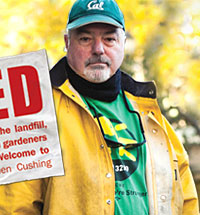Trashed
 At UC Berkeley, recyclables end up in the landfill, outdoor plazas are drowning in litter, and gardeners spend their days collecting garbage. Welcome to the world’s greenest university.
At UC Berkeley, recyclables end up in the landfill, outdoor plazas are drowning in litter, and gardeners spend their days collecting garbage. Welcome to the world’s greenest university.
Hank Chapot is tired. Tired because it’s early — before 7 a.m. on a cold December morning, sunshine just beginning to scrape the inky sky. Tired because he knows how long the day ahead of him will be. And tired because this isn’t quite what he signed up for when he came on as a campus gardener in 2003. This early on a Monday morning, the 6,651 acres that make up the University of California at Berkeley’s extensive grounds are strewn with wadded-up burrito wrappers, empty frozen-yogurt containers, broken beer bottles, and various other detritus of modern American college life. By the time students start flooding Sproul Plaza for 9 a.m. classes, all this — recyclables, garbage, and food waste alike — will have been piled up and carted out by Chapot and his fellow groundskeepers to be sent to a trash-sorting plant. Much of it will end up in the landfill. By the time they finish, the next day’s load will have already begun to pile up, ready to be cleared all over again.
With a sturdy build and eyes the color of ocean water, Chapot looks younger than his 57 years. But at this point, he says, work is starting to wear him down. He has torn both of his rotator cuffs on the job; after two successful surgeries — both paid for by worker’s compensation — he’s still working, but experiences pain in his shoulders and lower back. Not to mention the emotional anguish of the job: A self-described “lifelong nature-lover” and founding member of California’s Green Party, Chapot got into gardening because it meant being an environmental steward. Now, he finds himself spending most of his work time picking up garbage while the university’s once-magnificent grounds become overgrown and neglected.
Perhaps worst of all, though, is the fact that most of the contents in all of the campus’ outdoor recycling containers are never actually recycled. Instead, they end up in landfill-bound dumpsters.
Indeed, every day, most of the recyclables put in campus recycling cans are then mixed with garbage before being trucked to a Richmond solid waste-management facility for sorting. According to university administrators, the campus lumps all the material together because the recyclables are already contaminated: Students, staff, and visitors tend to put trash in the recycling containers on campus. However, once the mix of garbage and recyclables reaches the Richmond facility, many of the recyclables are not sorted out, particularly paper, because they’re too dirty to actually be recycled. Instead they go in the landfill.
At the same time, all that trash on campus makes for a disgusting and seemingly growing surface trash problem — one which has been spurred by budget cuts and staff shortfalls, and which has something of a spiraling effect, as groundskeepers like Chapot, hired as experienced gardeners, are now forced to spend most of their time picking up trash while the campus grounds fall further into hazardous disrepair.
Cal’s recycling and trash problems represent a stark contrast to the campus’ reputation as a beacon of progressivism and a thought leader when it comes to environmental issues. Earlier this year, UC Berkeley was awarded the distinction of being the world’s greenest campus, based on a number of factors, in a list published in the International Business Review; it’s also routinely ranked among the nation’s most environmentally friendly colleges by authorities like the Sierra Club. In 2008, the university made headlines when it unveiled a plan to produce zero waste by 2020 (an undeniably ambitious goal, especially for anyone who’s seen Memorial Glade, Sproul Plaza, or Strawberry Creek after a long, warm weekend). And that same year, the university hired a pedigreed new director of sustainability — Lisa McNeilly, who came from The Nature Conservancy and was previously a special assistant to the White House Climate Change Task Force. Under McNeilly, Cal has received accolades, both national and international, for several high-profile new initiatives: solar panels on the student union building, composting in several of the residence halls and co-ops, certified organic salad bars, and locally-grown produce in the cafeterias.
But still, the university has no meaningful means of dealing with one of its biggest — or at least most visible — problems: the several tons of trash and recyclables that do and do not get stuffed into bins all over campus.
For Chapot, as an environmentalist, one of the most personally affecting aspects of the problem is simply the massive amounts of recyclable materials that end up at the dump. “That’s what really breaks my heart,” he said over tea at a cafe near his North Oakland home. “A lot of this is stuff that could be recycled, and it’s just going into the landfill.”
According to Christine Shaff, a spokeswoman for the university’s facilities services, the university has no over-arching policy for sending surface-level recycling — that is, the stuff that’s not put in bins inside academic or administrative buildings or dorms — to recycling centers. Instead, it relies on a small number of homeless and low-income scavengers who come onto campus to dig through recycling bins and take what they want. It’s an informal (and, for that reason, unreliable) system, one which depends on an ad-hoc and unpredictable group of people and which can easily be disrupted — in the short-term by factors like weather, and in the long-term by the changing market value of certain recyclables. Moreover, these collectors can’t gather everything.
Read the full article by clicking the link below.
[ Source: East Bay Express ]


